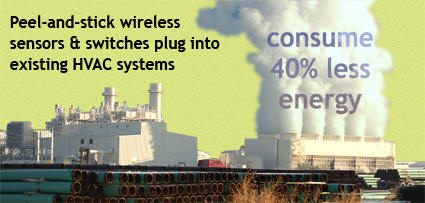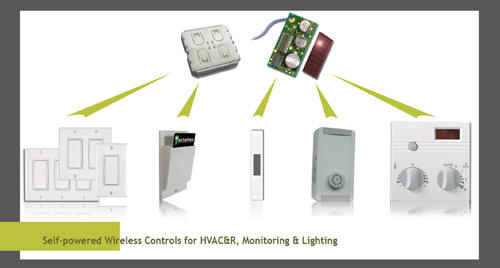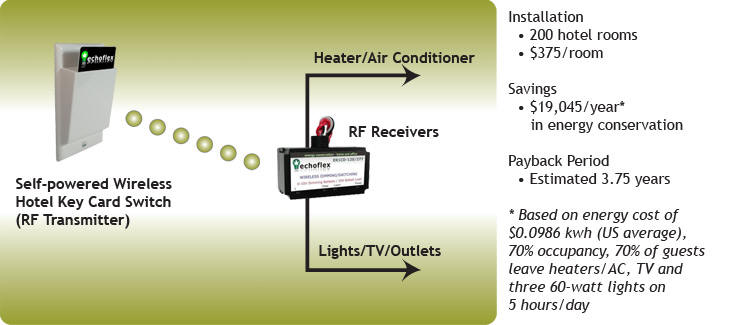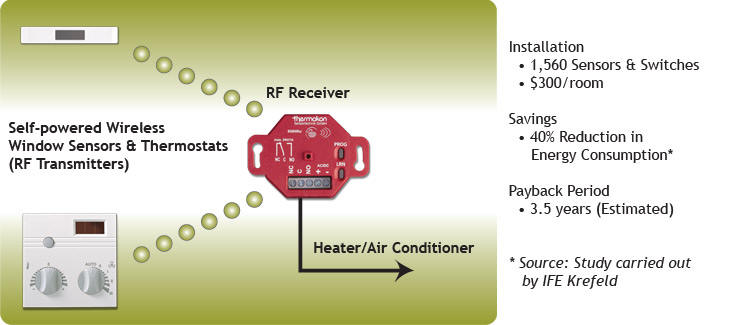March
2008
![]()
AutomatedBuildings.com
[an error occurred while processing this directive]
(Click Message to
Learn More)
March
2008 |
[an error occurred while processing this directive] |
|
|
Robert Eckery |
The Profitable Side of Intelligent Green Buildings
|
|
|
|
|
|
|
|
|
|
|
|
|
|
|
|
|
|
|
|
|
[an error occurred while processing this directive] |
In building automation, the word “green” often connotes “high cost”; and while green solutions have typically been good for the environment, they have not always been good for business. However, the fiduciary cases for implementing automation systems are becoming stronger. Early adopters of environmentally-friendly designs have effectively paid a premium that paved the way for today’s more cost-effective solutions.
This article explores the use of self-powered wireless controls for HVAC&R, monitoring and lighting control systems. Self-powered sensors, monitors and switches have been installed in over 10,000 buildings worldwide and are having positive effects on the economy and the environment. Take for example the hotel renovation project charted below. The proposed system is forecasted to reduce a hotel’s energy consumption by 40% and offset the initial investment in less than four years. In this application, an EnOcean-enabled self-powered wireless key card switch is used to reduce the amount of energy wasted on cooling, heating and powering unoccupied hotel rooms.
Credit/Debit Table
Projected costs and savings of installing
green controls in a 200-room hotel
|
|
Credits |
Debits |
Balance |
|
System Installation |
-- |
- $75,000 |
- $75,000 |
|
Year 1 |
+ $19,045 |
-- |
- $55,955 |
|
Year 2 |
+ $19,045 |
-- |
- $36,910 |
|
Year 3 |
+ $19,045 |
-- |
- $17,865 |
|
Year 4 |
+ $19,045 |
-- |
+ $1,180 |
|
Year 5 |
+ $19,045 |
-- |
+ $20,225 |
|
Years 6 - 20 |
+ $285,675 |
-- |
+ $305,900 |
The calculations used to arrive at these amounts are detailed in “Case Study 1”. The credit column does not include other tangible credit amounts such as dollars gained through LEED points.
The Opportunity
Energy inefficient buildings are easy to spot. Less evident, however, are cost-effective means that can stop the propagation of energy-waste. A building owner can easily document a building’s faults and then ask the contractor to propose an energy efficient solution. The building owner then must weigh the benefits of modernizing the building versus his or her own fiduciary goals. Building owners often elect to continue to feed an energy-hungry building more power rather than pay the cost of installing a new system.
Fortunately, green technologies have matured. Thanks to innovative engineering and premiums paid by early adapters, contractors can now present simple, cost-effective and field-tested solutions to prospective clients. Products such as peel-and-stick sensors simplify and expedite system integration; while providing the building owner a wireless sensor network that yields greater control of building space and more efficient power consumption. Case studies show that after a reliable wireless sensor network is put into place, energy consumption can be reduced up to 40 percent. And, over time, building owners recoup the initial cost of installation.
Figure 1 - The power of self-powered wireless sensor networks

Several groups benefit from the maturation of green controls. Building owners will spend less money powering their buildings. Contractors and architects will have more contracts and more options to offer building owners. Building tenants will have greater control of their building space.
Self-powered Wireless HVAC&R, Monitoring & Lighting Controls
Self-powered wireless networks are anchored by EnOcean-enabled sensors and switches. The sensors and switches can power themselves because they house energy-harvesters (micro power-generators that convert environmental energy, such as light or mechanical power, into useful radio transmissions). When coupled with a wireless module, EnOcean’s energy harvester enables sensors and switches to be self-powered. Self-powered means battery and wire-free. The absence of wires simplifies installations because installers do not run wires through walls. The absence of batteries simplifies network maintenance and saves money and natural resources over time. Once programmed and installed, the controls operate battery and maintenance-free for the life of the control (typically 20+ years). Installers and facility managers can affix the controls wherever they want which is particularly beneficial in building renovations and retro-fits.
Figure 2 – Self-powered
Wireless Controls
(Wireless Modules, Energy Harvesters and some examples of EnOcean-enabled
devices)

Virtually any sensor can become a self-powered wireless control when integrated with an EnOcean wireless module and energy harvester. Motion, CO2, humidity, light, temperature and window sensors are currently in production and available through various distributors and manufactures.
[an error occurred while processing this directive] CASE STUDY 1 – Hotel Renovation that Stops Unoccupied Room Energy Consumption
A contractor is currently pitching a self-powered wireless system to a hotel owner in Orlando, Florida. The renovation promises to reduce the amount of energy the hotel consumes and to satisfy the following requirements:
Reduce energy consumption in unoccupied rooms.
Avoid reliance upon batteries.
Maintain and improve hotel guests’ experiences.
Install the sensors and switches in a non-invasive manner. In other words, the hotel had to stay open for business during installations.
The contractor is proposing to install self-powered wireless hotel key switches in each room. The key card switch is an EnOcean-enabled wireless transmitter recently developed by Echoflex Solutions. The key switch operates without batteries and solves the problem of energy wasted on heating, cooling and lighting unoccupied hotel rooms.
The self-powered wireless key card switch performs as a master switch. When a guest enters a room, they insert their hotel key into a lighted dock. When the key card is inserted, a radio signal is transmitted that enables the room’s lights, electronics, heater and air conditioner. When the key card is removed from its dock, another radio signal is sent that, after allowing the guest 10 minutes to depart, disables the room’s powered amenities. In the scenario cited here, the hotel owner will make back the initial installation cost in 3.75 years and then pocket nearly $310,000 in net profits during the lifetime of the self-powered wireless sensors and switches (based on 20-years of maintenance-free operations).
Figure 3 - Conserving Power in Unoccupied Hotel Rooms

The following outlines how the savings of $19,045/year was figured:
Calculate the amount of power one hotel room
consumes in one hour. In this case, the sum of energy consumption per room
was 1,080 Watts.
1080 Watts = 750 Watts + 180 Watts + 150 Watts
(Heater/Air conditioner = 750 Watts; Three 60-Watt light bulbs = 180 Watts;
TV = 150 Watts)
Now multiply the following variables: Power usage
(in kilowatts); Number of rooms; Number of hours each room is left
unoccupied; Hotel occupancy percentage; Percentage of guests that leave
utilities on when they are not in the room; cost of electricity; number of
days in a year.
After multiplying the variables, the potential energy savings for one year
is $19,045.
$19,045 = 1.08 kW * 200 rooms * 5 hours * 70% occupancy * 70% of guests that
leave utilities on when outside the room * $0.0986 kWh * 365 days)
CASE STUDY 2 – HVAC Controls in a New Zealand College Dormitory
In 2006, New Zealand’s University of Canterbury modernized older dormitory buildings by installing a self-powered wireless control system. The installation satisfied the following requirements:
Reduce energy consumption and utility spending.
Avoid reliance upon batteries.
The installation of sensors cannot be invasive (building closures to be kept to a minimum).
The solution, in this case, was to install self-powered wireless window sensors (solar-powered magnetic contacts), thermostats and heating/air-conditioning controllers in each room. The window sensors monitored the Open/Closed status of each room’s windows. When a window is closed and a room is below a specified temperature, the heating unit turns on automatically. If either the temperature becomes too warm or a window is opened while the heating unit is on, the heating unit is automatically turned off. The system was installed without endeavoring time-consumptive labors, such as wiring or chiseling conduits.
Figure 4 - College Dormitory Renovation

SUMMARY
Installing a self-powered wireless network requires some clairvoyance. If an integrator can see beyond the glare of initial installation costs, the long-term gains outweigh the risk – both for the environment and for the businesses. Contractors and building owners now have access to products that protect the environment, preserve natural resources and stimulate economic growth. The benefits of self-powered wireless solutions also stretch beyond the scope outlined in these case studies. No attempt was made to attach a monetary value to other tangibles, such as the costs of battery-replacement. The green solutions cited in this article are not only good for the environment; self-powered wireless controls are also good for business.
For more information regarding the technologies described in this article, please visit www.EnOcean.com.
About the Author
Robert Eckery, Marcom Manager, EnOcean, Inc.
Robert has been an advocate for wireless solutions for the past six years –
managing the promotion and technical documentation of wireless sensor networks.
Most recently, his focus has been to pragmatically document the fiduciary
evolution of wireless system designs in the context of green building
automation.
[an error occurred while processing this directive]
[Click Banner To Learn More]
[Home Page] [The Automator] [About] [Subscribe ] [Contact Us]